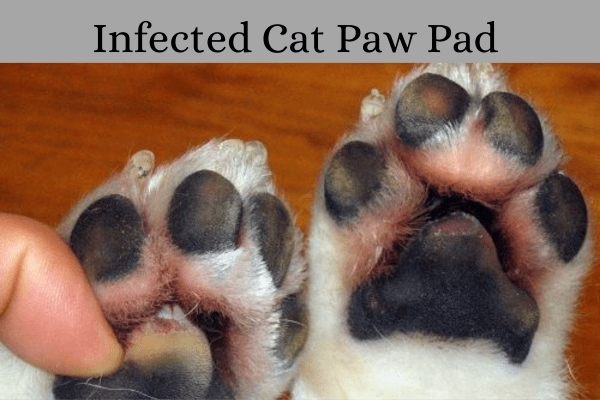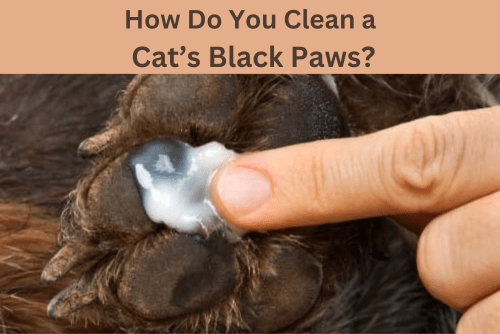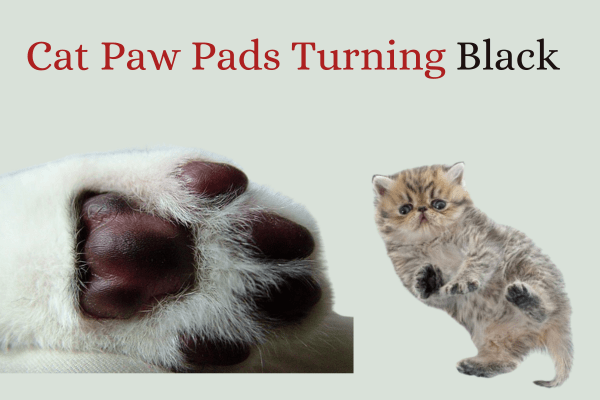Cat paw pads are the soft, cushion-like parts of the cat’s feet that help them walk, run, jump, and balance. They also serve as sensory organs that allow cats to feel the texture, temperature, and vibration of the surfaces they touch.
Cat paw pads turning black or in different colors, such as pink, black, or a combination of both, depending on the cat’s breed, age, and health. However, sometimes cat owners may notice that their cat’s paw pads turning black, which can be a cause for concern.
What does it mean when a cat’s paw pads turn black? Is it normal or a sign of a problem? we will explore the possible reasons why cat paw pads may change color to black, and what you should do if you notice this happening to your cat.
Contents
- 1 Cat Paw Pads Turning Black: Causes and Solutions
- 2 Why do cat paw pads turn black?
- 3 What does an infected cat paw pad look like?
- 4 Is it normal for a cat’s paw pads to change color?
- 5 How do you clean a cat’s black paws?
- 6 What is a home remedy for an infected cat paw?
- 7 What can you do to help your cat?
- 8 Conclusion
- 9 FAQs on cat paw pads turning black
Cat Paw Pads Turning Black: Causes and Solutions
If you have ever noticed your cat’s paw pads changing color from pink to black, you may have wondered what is causing this phenomenon. Is it typical or an indication of an issue? In this article, we will explore some of the possible reasons why your cat’s paw pads may turn black and what you can do about it.
What are cat paw pads?
Cat paw pads are the soft, cushiony parts of your cat’s feet that help them walk, run, jump, and balance. They have many nerve endings that let your cat sense vibration, warmth, and texture on surfaces they come into contact with, therefore they also serve sensory purposes.
Cat paw pads are made of a thick layer of skin called the epidermis, which covers a layer of fatty tissue called the subcutis. The subcutis acts as a shock absorber and helps regulate your cat’s body temperature.
The color of your cat’s paw pads depends on the amount and distribution of pigment cells called melanocytes in the epidermis. These cells produce a dark pigment called melanin, which gives color to your cat’s skin, fur, eyes, and paw pads.
Related Cat Health:
Cat Losing Hair In The Corner Of Its Eye
Cat Not Eating After Dental Surgery
Cat Leaving Blood Spots On Bed
Why do cat paw pads turn black?
Cat paw pads turning black, there are several possible reasons, ranging from normal to serious. Here are some of the most common ones:
- Aging: As your cat gets older, their melanocytes may produce more melanin, resulting in darker paw pads. This is a natural and harmless process that does not affect your cat’s health or well-being. Some cat breeds, such as Bombay and domestic shorthair and longhair breeds with black fur, may develop black paw pads earlier or more prominently than others due to their genetic makeup.
- Breed-specific pigmentation: Some cat breeds, such as Siamese, Birman, Himalayan, and Ragdoll, have a genetic trait called acro melanism, which causes their fur and paw pads to darken in response to lower temperatures. This is why these cats have darker points on their ears, nose, tail, and feet. This is also a normal and harmless process that does not affect your cat’s health or well-being.
- Fungal infections: Fungal spores are everywhere in the environment and can cause various skin and nail problems in cats. One of the symptoms of a fungal infection is peeling, cracking, or discoloration of the paw pads. Different types of fungi can cause similar symptoms, so it is important to get a proper diagnosis from a vet before starting any treatment. Fungal infections can be treated with topical or oral antifungal medications, depending on the severity and type of infection.
- Burns or frostbites: If your cat has recently walked on a very hot or cold surface, such as asphalt, concrete, or snow, they may have damaged their paw pads due to extreme temperatures. This can cause blisters, cracks, bleeding, or peeling of the skin, which may turn black as a result of scarring or infection. This can be very painful and dangerous for your cat, and it requires immediate veterinary attention.
- Fungal infections: Fungal spores are everywhere in the environment, and they can cause various skin problems in cats, such as ringworm, yeast, or dermatophytosis. One of the symptoms of a fungal infection is the peeling or blackening of the skin, which can affect the paw pads as well. Fungal infections are contagious and can spread to other parts of the body or other animals or humans. They need to be diagnosed and treated by a vet, usually with antifungal medications and topical creams.
- Contact dermatitis: Contact dermatitis is an allergic reaction to something that your cat has touched, such as chemicals, plants, or metals. It can cause inflammation, redness, itching, or swelling of the skin, which can also affect the paw pads. Contact dermatitis can be acute or chronic, depending on the frequency and duration of exposure to the allergen. It can be treated by identifying and avoiding the source of the allergy, and by applying anti-inflammatory or soothing agents to the affected area.
- Malignant melanoma: Malignant melanoma is a type of skin cancer that originates from the melanocytes, the cells that produce melanin. It can appear as a dark, irregular, or ulcerated growth on the skin, which can also affect the paw pads. Malignant melanoma is very aggressive and can spread quickly to other organs, such as the lungs, liver, or lymph nodes. If not identified and treated promptly, it may be lethal. The treatment options may include surgery, chemotherapy, radiation, or immunotherapy, depending on the stage and location of the tumor.
What does an infected cat paw pad look like?
An infected cat paw pad may look different depending on the type and severity of the infection. However, some common signs and symptoms of an infected paw pad are:
- Discharge: Your cat’s paw may have a yellow, green, white, or bloody discharge, especially if an abscess has burst. Pus is caused by a buildup of white blood cells that respond to the infection.
- Odor: An infected paw may emit an odd or strong smell.
- Swelling: The paw pad may appear enlarged, puffy, or inflamed due to fluid accumulation and tissue damage.
- Pain: The paw pad may be tender, sore, or sensitive to touch or pressure. Your cat may limp, hold up the paw, or avoid walking on it.
- Licking: Your cat may lick excessively and obsessively at the affected paw to soothe the pain or irritation. However, this may worsen the infection by introducing more bacteria or dirt into the wound.
- Fever: Your cat may have a fever as a result of the infection. Fever is a sign of inflammation and immune response, and may cause your cat to be lethargic, depressed, or lose appetite.

Is it normal for a cat’s paw pads to change color?
Cat’s paw pads are usually pink, black, or a combination of both. However, sometimes they may change color due to various factors, such as age, breed, temperature, health, or injury. Some color changes are normal and harmless, while others may indicate a serious problem that requires veterinary attention.
Normal color changes
Some cat breeds, such as Siamese, Himalayan, and Burmese, have a genetic trait called acromelanism, which causes their fur and paw pads to darken with age. This is a normal and natural process that does not affect their health or well-being.
Another common cause of paw pad color change is temperature. When cats are exposed to cold weather, their paw pads may turn from pink to black or vice versa. This is a result of blood vessels constricting or dilating to regulate body heat. This is also normal and reversible and does not indicate any health issues.
Abnormal color changes
Some color changes, however, may signal an infection, inflammation, or injury that needs medical attention. For example, if your cat’s paw pads turn red, swollen, or hot, it may indicate a condition called pododermatitis, which is an inflammation of the skin and tissue of the paw.
This can be caused by various factors, such as allergies, parasites, trauma, autoimmune disorders, or tumors. Pododermatitis can be very painful and may lead to secondary infections or complications if left untreated.
Another example of abnormal color change is when your cat’s paw pads turn yellow or brown. This may indicate a liver problem, such as hepatitis, cirrhosis, or jaundice. Liver disease can affect the production and metabolism of bilirubin, a pigment that is excreted in urine and feces.
When bilirubin accumulates in the blood, it can cause the skin, eyes, and mucous membranes to turn yellow or brown. This is a dangerous ailment that has to be treated by a veterinarian right away.
How do you clean a cat’s black paws?
Cleaning a cat’s black paws is similar to cleaning any other color of paw, except that you may need to pay more attention to the dirt or debris that may be hidden in the dark fur. Here are some steps to clean a cat’s black paws:
- Prepare the supplies: You will need a bowl of warm water, a mild soap or shampoo, a towel, a soft brush, and a nail clipper. You may also need a pair of scissors or a razor to trim the fur around the paw if it is too long or matted.
- Hold your cat: You may need to restrain your cat or have someone else hold it while you clean its paws. You can wrap your cat in a towel or a blanket to prevent it from scratching or biting you. Alternatively, you can use a cat carrier or a crate to confine your cat and only expose one paw at a time.
- Wet the paw: Dip the paw in a bowl of warm water or use a wet cloth to moisten the paw. Avoid using hot or cold water, as they may cause discomfort or shock to your cat.
- Apply the soap: Use a small amount of mild soap or shampoo to lather the paw. Massage the soap into the fur and skin, and use the soft brush to scrub the dirt or debris gently. Be careful not to rub too hard or hurt the paw pad or the nails.
- Rinse the paw: Rinse the paw thoroughly with clean water to remove any soap residue. You can use a spray bottle or a faucet to rinse the paw or dip it in another bowl of clean water. Make sure the water is not too hot or too cold, and avoid spraying water directly into the paw pad or the nails.
- Dry the paw: Use a towel to pat the paw dry. Do not rub or squeeze the paw, which may cause irritation or injury. You can also use a hair dryer to dry the paw, but make sure it is on a low setting and keep it at a safe distance from the paw. Do not use a hair dryer if your cat is afraid of the noise or the heat.
- Trim the nails:
Use a nail clipper to trim the nails if they are too long or sharp. Hold the paw firmly and gently press the pad to expose the nail. Cut the nail below the pink part, the blood vessel, and the nerve. Avoid cutting the pink part, as this may cause bleeding and pain. If you accidentally cut the pink part, use a styptic powder or cornstarch to stop the bleeding. You can also file the nails with a nail file to smooth the edges and prevent scratching.
- Trim the fur Use a pair of scissors or a razor to trim the fur around the paw if it is too long or matted. This will prevent the fur from trapping dirt or debris, and make it easier to clean the paw. Be careful not to cut the skin or the paw pad, and avoid trimming the fur too short, as this may expose the paw to cold or injury.

What is a home remedy for an infected cat paw?
Some home remedies may help treat a mild or minor infected cat paw, such as:
- Aloe vera: Aloe vera is a natural plant that has anti-inflammatory and antibacterial properties. You can apply aloe vera gel to the infected paw to soothe the pain and promote healing. You can use a fresh aloe vera leaf or a store-bought aloe vera product that is pure and organic. Avoid using aloe vera products that contain alcohol, fragrance, or other additives that may irritate the wound or your cat.
- Epsom salt: Epsom salt is a mineral compound that has antiseptic and anti-inflammatory effects. You can soak the infected paw in a warm water solution with Epsom salt to draw out the infection and reduce the swelling. You can use 1/4 cup of Epsom salt per gallon of water, and soak the paw for 10 to 15 minutes once or twice a day. Make sure the water is not too hot or too cold, and dry the paw thoroughly after soaking. Do not let your cat drink the water or lick the paw, as Epsom salt can be toxic if ingested.
- Turmeric: Apply a paste of turmeric powder and water to the infected paw to fight bacteria and inflammation.
What can you do to help your cat?
If you notice that your cat’s paw pads are turning black, the first thing you should do is examine them carefully and look for any signs of injury, infection, or abnormality. If you see any of the following, you should take your cat to the vet as soon as possible:
- Blisters, cracks, bleeding, or pus
- Swelling, redness, or warmth
- Pain, limping, or difficulty walking
- Loss of appetite, lethargy, or fever
- Any other unusual or suspicious growth or change
On the other hand, if your cat’s paw pads are black but otherwise healthy and normal, you may not need to worry too much, as long as you monitor them regularly and keep them clean and protected. Here are some tips to help you care for your cat’s paw pads:
- Trim your cat’s nails regularly to prevent them from scratching or injuring their paw pads
- Provide your cat with a scratching post or pad to help them groom their nails and remove dead skin cells
- Avoid letting your cat walk on hot or cold surfaces, especially in the summer or winter months
- Check your cat’s paw pads for any foreign objects, such as thorns, glass, or dirt, and remove them gently with tweezers or a damp cloth
- Clean your cat’s paw pads with a mild soap and water, or a cat-friendly wipe, and dry them thoroughly with a soft towel
- Apply a moisturizing or healing balm to your cat’s paw pads, such as coconut oil, shea butter, or aloe vera, to prevent dryness or cracking
- Avoid using any products that contain alcohol, fragrance, or harsh chemicals on your cat’s paw pads, as they may irritate or damage the skin
- Consult your vet before using any over-the-counter or home remedies on your cat’s paw pads, as they may not be suitable or safe for your cat.
Conclusion
Cat paw pads are an essential part of your cat’s anatomy and health, and they deserve your attention and care. While some color changes may be normal and harmless, others may indicate a serious problem that needs medical attention. By knowing the possible causes and solutions for cat paw pads turning black, you can help your cat stay happy and healthy.
FAQs on cat paw pads turning black
Q: Why are my cat paw pads turning black?
- A: Your cat’s paw pads may turn black due to normal aging, breed-specific pigmentation, burns, frostbites, fungal infections, gangrene, or other health issues. Some of these causes are harmless, while others may require veterinary attention.
Q: How can I prevent my cat’s paw pads from turning black due to burns or frostbite?
- A: You can protect your cat’s paw pads from extreme temperatures by keeping your cat indoors, especially during hot or cold weather. Avoid letting your cat walk on hot or icy surfaces, such as asphalt, concrete, or metal. If your cat does get burned or frostbitten, seek veterinary care as soon as possible.
Q: How can I treat my cat’s paw pads if they are infected or inflamed?
- A: You can clean your cat’s paw pads with a mild antiseptic solution, such as chlorhexidine or povidone-iodine, and apply a topical antibiotic ointment, such as Neosporin or Bacitracin. You can also cover the paw pads with a bandage or a sock to prevent your cat from licking them. Your veterinarian may also prescribe oral antibiotics or pain medication for more severe cases.
Q: How can I tell if my cat’s paw pads are turning black due to gangrene?
- A: Gangrene is a serious condition that occurs when the tissue dies due to lack of blood flow or infection. Gangrene can cause your cat’s paw pads to turn black, gray, or brown, and emit a foul odor. The paw pads may also be cold, hard, or dry to the touch. If you suspect your cat has gangrene, contact your veterinarian immediately, as it may require surgery or amputation.
Q: How can I know if my cat’s paw pads are turning black due to normal or breed-specific reasons?
- A: Some cat breeds, such as Siamese, Himalayan, and Burmese, have a genetic trait that causes their fur and paw pads to darken with age. This is a normal and natural process that does not affect their health or well-being. You can check your cat’s breed history or consult your veterinarian to confirm if this is the case for your cat.




